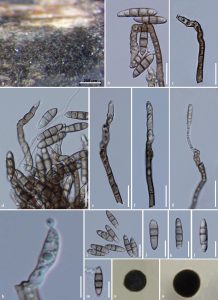Proliferophorum thailandicum G.N. Wang, H. Zhang, K.D. Hyde & Senan., sp. nov.; Index Fungorum number: IF555400
Etymology: In reference to Thailand, where the species was collected.
Holotype: MFLU 17-1054
Saprobic on decaying, submerged wood in freshwater habitat. Sexual morph: Undetermined. Asexual morph: Colonies irregular, hairy, black, gregarious. Mycelium mostly immersed in substratum, consisting of branched, septate, subhyaline to pale brown, smooth hyphae. Conidiophores macronematous, mononematous, caespitose, cylindrical, unbranched, erect, straight and curved at the upper part, dark brown, light brown at the apex, 8–10-septate, not constricted at the septa, 50–100 × 4–7 μm (x̅ = 82 × 5.5 μm , n = 10), smooth, sometimes percurrently proliferating 1–2 times at broken ends, with few upper cells guttulate. Conidiogenous cells holoblastic, polyblastic, terminal, sympodial, pale brown or subhyaline, up to 20–30 μm long, with minute, truncate conidiogenous loci. Conidia fusiform to cylindrical, aseptate when young, 2–3-septate when mature, rarely up to 4-septate, slightly constricted at the septa, dark brown at central cells, pale brown at end cells, guttulate at some stage, dry, smooth, 15–25 × 3–7 μm (x̅ = 23 × 5 μm , n = 20).
Culture characteristics: Colonies on PDA reaching 10 mm diam. within 15 days at 25 °C, colony circular, medium dense slightly raised to umbonate, surface slightly rough with edge entire, floccose to velvety, colony from above and below black; not producing pigmentation in
agar.
Material examined: THAILAND, Chiang Rai Province, Longkhot Subdistrict, saprobic on decaying submerged wood in a stream, 1 September 2017, G.N Wang, 4.14.1 (MFLU 17-1054, holotype), ex-type living culture, MFLUCC 17-0293. GenBank numbers: ITS = MK028344, LSU = MK028343, SSU = MK028345.
Fig. Proliferophorum thailandicum (MFLU 17-1054, holotype). a Colonies on submerged wood. b–h Conidiophores. i–l Conidia. m Germinated conidium. n Colony on PDA (from above). o Colony on PDA (from below). Scale bars a = 200 μm , b–g = 20 μm, h = 10 μm , i–l = 10 μm .

